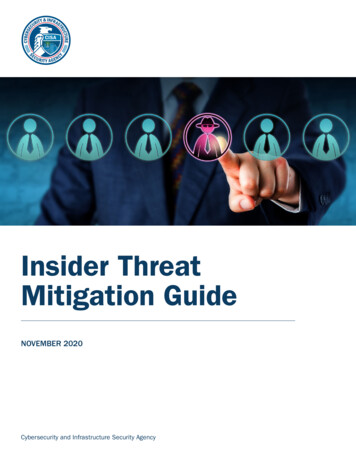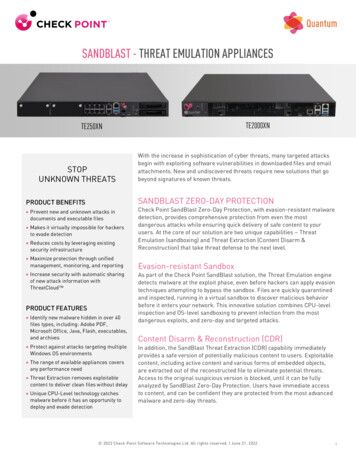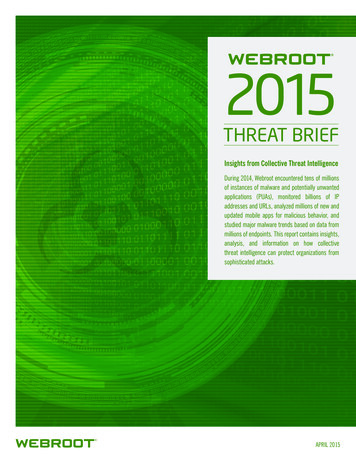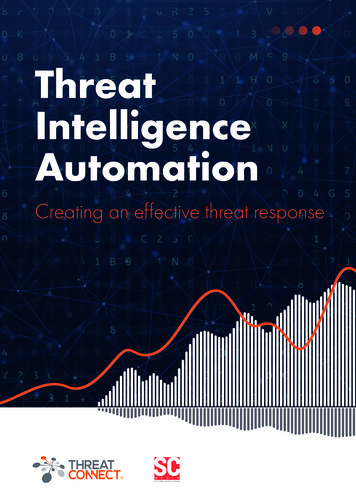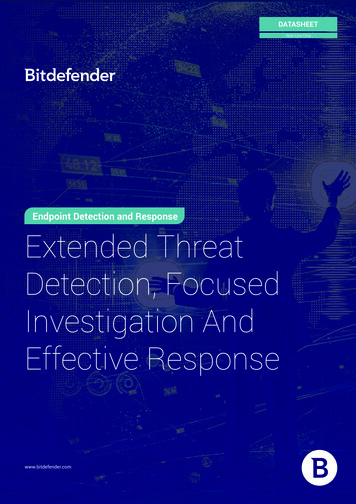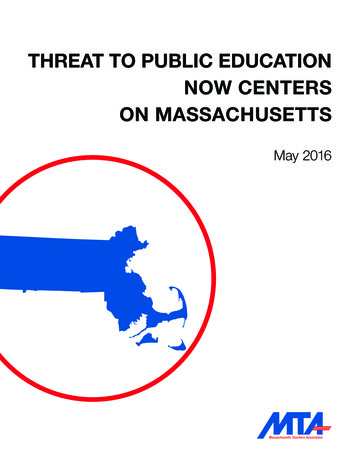
Transcription
THREAT TO PUBLIC EDUCATIONNOW CENTERSON MASSACHUSETTSMay 2016
PrefaceThis document updates and expands on Threat from the Right, an MTA task force report issued inMay 2013. During the intervening years, the threat to public education, organized labor and socialjustice has grown substantially. Massachusetts is now in the crosshairs, with the forces behindcharter schools, privatization and other attacks on the public good coalescing on Beacon Hill andthroughout the state. That is reflected in the title of the 2016 edition, Threat to Public EducationNow Centers on Massachusetts. No one should doubt the danger of the challenges outlined in thesepages or the intensity of the forces behind them, which are national in scope. Nevertheless, winningthe many fights we face is well within the power of the MTA and our allies — parents, students andother members of communities across Massachusetts and the nation. Understanding our opponentsis an important step, and this report is intended to help us move toward meaningful victories aswe continue to organize, mobilize and build the power we need to realize the goals of our StrategicAction Plan.
ContentsIntroductionElements of the Charter CampaignThe Massachusetts Alignment.7Great Schools Massachusetts.9Families for Excellent Schools.11The Pioneer Institute.16The Investors: Massachusetts Campaign Money.19The Boston Foundation.23Other State Political PlayersThe Massachusetts Fiscal Alliance.29The Beacon Hill Institute at Suffolk University.31The Massachusetts Anti-Tax Movement.34Key National Donors, Funds and OrganizationsCharles and David Koch.39The Walton Family Foundation.41The Bill & Melinda Gates Foundation.43Charter funds: NewSchools Venture Fund and New Profit.47NewSchools Venture Fund.47New Profit, Inc.50Strategic Grant Partners.53The Eli and Edythe Broad Foundation.54The Laura and John Arnold Foundation.55DonorsTrust and Donors Capital Fund.56The Lynde and Harry Bradley Foundation.57The Jaquelin Hume Foundation.58Americans for Prosperity.59FreedomWorks.62The Heritage Foundation.65The State Policy Network.68The American Legislative Exchange Council.71StudentsFirst.74The Foundation for Excellence in Education.76The Association of American Educators.80Conclusion. 85Source Notes. 89
Threat to Public Education Now Centers on Massachusetts IntroductionIntroductionThe threats aligned against public education and unions today are broad, deep and substantial.More and more, they are focused on Massachusetts, where proponents of charter school expansionare preparing to spend millions of dollars as they test just how far they can go in privatizing publiceducation and profiting off the public good. The outcome of this assault is vital to the future of ourCommonwealth — and to the future of public schools, colleges and universities across the nation.For MTA members and students, this is nothing short of an existential struggle.Key battlegrounds include the Legislature, the courts, Congress and the governing bodies of everycity and town in Massachusetts, along with all types of media. Elements crucial to success or failureinclude elections for political office at all levels, ballot initiatives, and debates in every policy arena.With the stakes so high, it is no wonder that the forces arrayed against unions andallied social justice organizations are strong, influential and expansive. These forces areactive in Massachusetts and nationally — and, as this report will demonstrate, thereis often little or no space between funders, foundations, policymakers, operators ofcharter schools, proponents of education “reform” and advocates for small governmentand privatization. Much of their spending is opaque, and many donors to right-wingadvocacy organizations and other funders do not disclose their contributions.Old-line benefactors — including the Koch brothers, the Walton family and the Eli andEdythe Broad Foundation — continue to contribute massive amounts of money to thefights they take on. But now they are joined by a new breed of “venture philanthropists”eager to use their vast fortunes to shape policy changes.The forces that havelong sought to privatizeeducation to reducegovernment are nowpicking up steam fromthose who see schools andcolleges as just anotherbusiness challenge opento disruption.As always, undermining unions is an important part of the agenda. One key difference in recentyears, however, lies in a blurring of ideologies that seeks to merge nonprofit and for-profit interests.The forces that have long sought to privatize education to reduce government are now picking upsteam from those who see schools and colleges as just another business challenge open to disruption.Some wealthy individuals have signed the “Giving Pledge,” promising to devote much of theiraccumulated money to causes they support during their lifetimes. Former Enron executive-turnedhedge-fund-manager John Arnold and his wife, Laura, are among them. The Arnolds, who arebackers of the National Alliance for Public Charter Schools, have provided at least 25 millionto boost charters in Louisiana, 22 million to Teach for America, 7.5 million to StudentsFirst, 5 million to Stand for Children and a minimum of 1 million to Families for Excellent Schools.They say they will work full time at the Laura and John Arnold Foundation for many years to comeand intend to “exhaust most or all” of their estimated 3.5 billion in accumulated wealth on issueadvocacy that has included challenging the structure of public pensions.The Chronicle of Philanthropy notes that the Arnolds are “the youngest among the top givers — bymore than two decades in most cases.” John Arnold says: “We have the benefit of being young, so wecan look at very complicated problems. We have years to see these through.”1
Threat to Public Education Now Centers on Massachusetts IntroductionIn Massachusetts, charter schools, which are draining more than 400 million a year from localdistricts, are at the center of the storm. As the Legislature considers lifting the cap on the number ofCommonwealth charters and allowing an even greater diversion of public funds to private interests,proponents are mounting legal action and threatening to spend untold sums on a ballot initiative thisNovember.Governor Charlie Baker has made charter expansion a top priority, mirroring his privatization effortsinvolving transportation and other public services. Baker vows to hold the line on taxes despite themyriad unmet needs that persist year after year for our public schools, colleges and universities, aswell as for early childhood education. Make no mistake: The governor remains faithful to a hard-lineconservative ideology even as he puts forth a moderate front.With his ascension to the corner office, some of the groups profiled in this report are taking on a highlevel of prominence. One of them is the Pioneer Institute, a member of the State Policy Network withextensive ties to Baker. Another is the NewSchools Venture Fund, where Education Secretary JamesPeyser was an executive for many years.Support from Baker and Peyser is a boon to Great Schools Massachusetts and the New York-basedFamilies for Excellent Schools, which are leaders in the campaign to allow an unlimited number ofnew charter schools — up to a dozen each year without end — to open in Massachusetts.The impact? Billions of dollars more would be taken from our public schools and placed in privatehands, students would be subjected to a two-track system of education, and the jobs of unionizededucators would be lost by the hundreds each year.The effort to expand charters in the Commonwealth corresponds with actions on many otherfronts in many other states — including efforts to privatize elements of public higher education, thepromotion of school vouchers, assaults on pensions and benefits, and broad legal attacks on publicsector unions. Friedrichs v. California Teachers Association, a U.S. Supreme Court case that sought toend agency fees and allow free riders to benefit from unions’ collective bargaining activities, was anexample of this nationwide strategy.The court’s disposition of the case, handed down in March, came as a relief, but left the central issuesunresolved. In leaving the current law intact, the unexpected end of Friedrichs provided a measure offairness not only to organized labor, but also to the governmental and political processes. Moreover,it served to underscore the importance of this year’s presidential election, in which voters will choosewho nominates justices to the court for four potentially pivotal years.In that context, it pays to remember that Friedrichs was far from the only anti-union case in thejudicial pipeline. As MTA General Counsel Ira Fader noted recently in MTA Today: “One of themost virulently anti-union legal outfits in the country — the National Right to Work Legal DefenseFoundation — is litigating a Friedrichs-style case that is pending now in the Massachusetts appellatecourts. The foundation has openly acknowledged its intent to take the case to the Supreme Court.Now that Friedrichs is over, this case could be next.”In the following pages, readers will find cause for concern, and perhaps alarm. Although no such reportcan cover every group or every entanglement present in the web of big money and advocacy, there isabundant evidence here that achieving victory in Massachusetts is part of a broader playbook — and itis serious business to the forces that are out to destroy public education and educators’ unions.2
Threat to Public Education Now Centers on Massachusetts IntroductionThe answer to defeating this all-out assault is no great mystery, and MTA members — along withparents, students, allied organizations and many others — are at the heart of it. At this writing, theMTA is taking many steps at once, all of them involving the kind of relentless organizing that createdpower for educators and other working people in the first place.Not long ago, the MTA collected more than 29,000 signatures for the Raise Up Massachusettscampaign, which seeks to place an additional tax on annual income exceeding 1 million, bringing inbillions of dollars over the years ahead for public education and transportation.Today, the charter campaign is front and center. We are working closely with fellow members ofthe Massachusetts Education Justice Alliance, a coalition of community groups, parents and unionsformed to take on the many issues challenging our public schools: lack of funding, high-stakestesting and the state’s rigid accountability regime, as well as charter expansion. MEJA has organized aballot campaign called Save Our Public Schools to fight the charter question, and the MTA is a leaderin that effort.The threat to public education and unions will not go away. But it can be countered forcefully andeffectively if union members join others in their communities in organizing for power and thenusing it wisely and well. Understanding the current situation is a key step along that road, and theinformation presented here will be helpful in that regard.3
ELEMENTS OF THECHARTER CAMPAIGN
Threat to Public Education Now Centers on Massachusetts Elements of the Charter CampaignThe Massachusetts AlignmentCharter enrollment has grown by 100 percent nationally since 2007-2008, and privatized schoolshave expanded rapidly in New Orleans and other cities. But proponents remain frustrated by whatthey view as a lack of recent progress in expanding the charter footprint.The right-leaning Center for Education Reform, which ranks state charter laws, noted with somefrustration in 2015: “Charter school growth does continue at a steady, nearly linear pace nationally,especially in states with charter laws graded ‘A’ or ‘B,’ but an even more accelerated pace would allowcharter schools to play a more central role in addressing the demands and needs of our nation’sstudents.” This pressure for action is clearly evident in Massachusetts, where charter advocates arepursuing a three-pronged attack — through the courts, the Legislature and the ballot box — toincrease the number of charter schools.Many of the money figures behind the charter push — investors and venture capitalists with accessto cash through their firms and their vast personal wealth — are people not accustomed to waitingfor results. They want to “disrupt” education and change the “output” — overhauling how schoolsare created, managed and run. They join more experienced education “reformers” who have spentyears investing in the vast network of think tanks, advocacy organizations, legal groups and fundingvehicles to make a coordinated push for a greater private role in schools.What brings them together in Massachusetts in 2016 is a seemingly perfect alignment:a supportive governor, a legislature with key members who are listening, a growingnetwork of professional “grassroots” groups working in concert with established policyorganizations, and a deep bench of donors who have long been dabbling in charterschool operations and investing in educational products with the potential for hugereturns. These players have worked together with varying success in recent years inConnecticut, New York, Louisiana, California and Washington state.Supporters of public education face a steep challenge in this atmosphere. It may be easyto identify why charter proponents are pushing for change and what elements theyare bringing together to force that change, but how much they can devote to a full-oncharter assault may be unknowable.Many of the money figuresbehind the charter push— investors and venturecapitalists with access tocash through their firmsand their vast personalwealth — are people notaccustomed to waiting forresults.The money from education privateers that can be identified and counted in the drive to raise theMassachusetts charter school cap is merely the tip of the iceberg — just a whiff of the potentiallytens of millions of dollars poised to be spent pressing for more charter schools. Public filings forthe charter campaign and for legislative lobbying expenses show dollars raised and spent on charteradvocacy, but that reflects only a small share of the vast resources being assembled.The campaign committee for the charter ballot campaign, Public Charter Schools for Mass, filed itsfirst report in January 2016, reporting just under 500,000 raised for a ballot measure. Contributionsincluded eight 40,000 donations from individuals and 70,000 from a political committee linked tostate Republicans. Such filings cover general expenses for any campaign, such as signature-gatheringcosts. Lobbying reports for charter advocates show public relations costs and some organizingexpenses for staging rallies.7
Threat to Public Education Now Centers on Massachusetts Elements of the Charter CampaignBut what the campaign and lobbying reports fail to reflect is the millions already spent to sway publicopinion and create the illusion of vast grassroots support for raising the state charter cap. They do nothint at the millions more to come — additional money that will be expended by some of the samecampaign donors, their corporate education reform colleagues and other out-of-state funders withcharter interests.These charter resources are showing up in new advocacy groups making a splash in the state, such asFamilies for Excellent Schools and the charter-educator organization Educators 4 Excellence — outof-state entities with a new Massachusetts presence. More potential campaign money is buried insidethe workings of political operations associated with the Great Schools Massachusetts coalition, suchas Education Reform Now and its sister group, Democrats for Education Reform.Because nonprofit groups such as these file tax returns in the years after money is spent, it isimpossible to track all of the resources committed to the Massachusetts charter drive in real time. Butexperiences in other states and the track records and intertwined relationships of charter advocatesand their donors hint at the extensive resources primed for impact.In January, The Boston Globe reported that a “business-backed coalition” was “poised to spendup to 18 million and obliterate state campaign spending records in favor of expanded charterschools.” The story noted that Great Schools Massachusetts, the “umbrella group” for the campaign,had warned that if it was not satisfied with charter legislation, it would “press ahead with a ballotmeasure.” The article continued: “The group is prepared to take to the airwaves, step up its legislativelobbying, and deploy canvassers if a charter school question lands on the ballot, the people familiarwith its intentions said.”Now, with the issue almost certainly headed for the ballot in November, it is clear that assumingthe proponents’ threats are real, the Commonwealth will be at the center of an all-out campaign toease the frustrations of the national pro-charter forces — an effort that will be sharply countered byparents, students, community coalitions, union members and others.8
Threat to Public Education Now Centers on Massachusetts Elements of the Charter CampaignGreat Schools MassachusettsPressures building both within the Commonwealth and outside its borders have converged this yearin legislative, legal and political efforts to expand charter schools in Massachusetts. Proponents’ focus— and the support of many donors — have shifted to the state for the battle and united under theumbrella of a group calling itself Great Schools Massachusetts.Since 2013, charter advocates representing business interests, right-leaning donors, investors andexisting charter schools have been working to assemble the resources and infrastructure needed for afull-scale charter campaign. Out-of-state donors and Massachusetts charter donors have pitched in toensure that local groups have sufficient resources to finance a protracted fight. Proponents have saidthey are willing to spend 18 million for the charter campaign, though millions have already beenspent laying the groundwork for legislative, judicial and voter consideration.Although there are Massachusetts members of the coalition, Great Schools Massachusetts is notmerely a local group of concerned parents and community members advocating for a changein the state’s charter laws. Instead, GSM is a collection of some groups with local ties and otherorganizations that have worked in Massachusetts with the backing of out-of-state donors who havechallenged “traditional” public schools in California, Connecticut, Illinois and New York, often toincrease the number of charter schools and weaken educators and their unions.Seeds of the campaign in 2013. The Boston Foundation supported “raise the cap”legislation in 2013, only to see it die the next year in the state Senate. In 2013, inwhat would foreshadow the 2016 charter campaign, The Boston Foundation gavethe Massachusetts Charter Public School Association a three-year 100,000 grant “tosupport its campaign to expand and improve charter schools and to support effortsto raise the charter school cap in Massachusetts.” The president of the MassachusettsCharter Public School Association is Beth Anderson, Phoenix Charter AcademyNetwork founder and CEO. She is also chairing the Public Charter Schools for Massballot committee.Advocacy groups began assembling their money in 2014 to make a play forMassachusetts. Records show that donors gave the New York group Families forExcellent Schools funding that year to open a Boston office, preparing to mobilize for amajor legislative effort and, if needed, a ballot initiative push.Since 2013, charteradvocates representingbusiness interests, rightleaning donors, investorsand existing charterschools have been workingto assemble the resourcesand infrastructure neededfor a full-scale chartercampaign.Political money was moving around as well. Democrats for Education Reform, a sister nonprofit tothe well-funded Education Reform Now charter advocacy group, poured money into the Bostonmayoral race and later into legislative campaigns to elect “education reform friendly” candidates. Allof these groups and others joined with local business groups and a handful of community groupsin late 2015 to put up a united front with Governor Charlie Baker on behalf of charter schools,launching Great Schools Massachusetts.GSM members and supporters represent education, advocacy and business groups, with someoverlap in donors and some leaders.9
Threat to Public Education Now Centers on Massachusetts Elements of the Charter Campaign Families for Excellent Schools, the rapidly growing advocacy group that spent a record amountof money in New York and lobbied heavily in Connecticut, counts on funders such as the WaltonFamily Foundation of Arkansas, the California venture philanthropy fund NewSchools VentureFund, and Texans John and Laura Arnold. Californians Eli Broad and Bill Oberndorf, longtimesupporters of privatizing education, have supported FES through their foundations. FES donorsinclude the foundation of New Yorker Gideon Stein, who advocates for charters while sellingschools education technology, and DonorsTrust, which collects support from right-leaningfunders such as the Koch, Coors and Scaife families.The group that provided early money for FES, the New York-based Education Reform Now,was moving money over to Democrats for Education Reform, an independent expenditurecommittee active in Massachusetts legislative campaigns in 2014 and 2016.Many Bostonians know Democrats for Education Reform for making a significant splash inthe 2013 mayoral race. DFER reported spending 1.7 million to help elect what it called an“education reform friendly mayor”; the committee backed the unsuccessful mayoral campaign ofthen-City Councilor John Connolly. DFER had been led by Joe Williams, who left the group in2015 to run an education advocacy initiative of the Walton Family Foundation.Unsurprisingly, local anti-tax groups that favor reduced spending on government services,including schools, have joined the coalition. The Massachusetts Taxpayers Foundation andMassachusetts Fiscal Alliance are both on board. The MTF has collected at least 65,000 fromBoston Foundation donors in recent years.At least four business groups, some unfriendly to labor, have joined Great Schools Massachusetts.They include the Greater Boston Chamber of Commerce, the Massachusetts Business Roundtableand the Massachusetts Technology Leadership Council. Also a member is the nationwidecommercial real estate development association NAIOP, which calls itself the “acknowledgedleader in real estate advocacy and policy development for owners, developers and investors.”Developers will be watching the outcome of the charter battle closely, given that charter schoolsspend hundreds of thousands of dollars — sometimes millions — on finding sites for schools anddeveloping property.Great Schools Massachusetts will not only rely on local and out-of-state funding from donors whowant more charter schools for financial or ideological reasons, it will also get support from educationadvocacy groups eager for more progress in the fight to expand the national charter footprint.They include groups such as the right-funded Center for Education Reform, which has long toutedprivate vouchers as alternatives to public schools and more recently has served as a vocal voice forcharter schools. CER ranks charter school laws and gave Massachusetts a “C-” grade for failing tohave an independent authorizer and for its cap on the number of schools. CER, which shares somedonors with Families for Excellent Schools, is helping out by providing links on its website to theMassachusetts campaign and its “Fact Check” feature on charter schools.10
Threat to Public Education Now Centers on Massachusetts Elements of the Charter CampaignFamilies for Excellent SchoolsFamilies for Excellent Schools — which has now expanded to Massachusetts to join the threepronged offensive to lift the charter school cap — has previously worked in New York andConnecticut, pouring money into advocacy and political campaigns and enlisting parents andfamilies as it seeks to suggest a groundswell of community support for charters. Donors who supporta greater private role in education, seeing Massachusetts as the next significant charter battleground,provided the seed money to open the local FES affiliate in 2014. FES became a vocal member of theGreat Schools Massachusetts coalition, organizing and lobbying to advocate for charters through a“Unify Boston” campaign.Today, FES draws money from old-line donors who want to privatize schools to shrink the size ofgovernment. But it is also a tool of investor-donors who have created interlocking advocacy groups tohelp capture a share of the public money flowing to schools.A swift impact on New York charter schools. FES is a relatively new group that wasramped up quickly to impact state charter debates. From its start, it joined a jumbleof New York advocacy groups linked together by donors and leaders. By 2014, it wasdumping millions of dollars of hard-to-track political and lobbying money into NewYork’s charter school debate.The growing impact of the group can be seen clearly in the period between July 1, 2011,and June 30, 2014. The 501(c)(3) FES nonprofit began with 1.1 million in reportedrevenue for its first fiscal year. By the end of its third fiscal year, it reported 12 millionin revenues. In 2014, FES and its companion 501(c)(4) political arm, FES Advocacy,shared a New York address with StudentsFirst New York, also home to New Yorkers fora Balanced Albany, which was created by StudentsFirst to support Republicans friendlyto its agenda in the New York State Senate. The allied group Education Reform Now,parent of Democrats for Education Reform, provided funding for FES in its first yearof operation, both directly and through a New York charter group called The TapestryProject. All of these groups have shared donors.Today, FES draws moneyfrom old-line donorswho want to privatizeschools to shrink the sizeof government. But it isalso a tool of investordonors who have createdinterlocking advocacygroups to help capture ashare of the public moneyflowing to schools.FES has myriad ties to the New York charter community, not the least of which is its connectionwith The Tapestry Project, which was started by Eric Grannis, husband of Success Charter Academyfounder Eva Moskowitz — a central and highly controversial figure in the charter school drive.FES reported spending on event costs, advocacy and organizing, and in its first year it paid nearly 100,000 for “parent stipends” while moving money over to FES Advocacy for political action andorganizing parents. In 2014, FES spent a record 9.7 million lobbying for charter-friendly legislation,and FES expenditures included 3.6 million spent
charter schools, privatization and other attacks on the public good coalescing on Beacon Hill and throughout the state. That is reflected in the title of the 2016 edition, Threat to Public Education Now Cent

